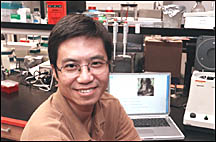|
|
|
|
|
September 27, 2002Gu puts backbone in evolution
Evolution. It's an age-old topic with many aspects that have been argued for years. What? When? How did we get backbones? Xun Gu knows. In fact, the associate professor of agronomy just confirmed a 30-year-old, unproven evolution theory, a finding that could lead to new drugs for treating cancer and major public health diseases. Gu said the ongoing study also could pinpoint what type of animal (fish, frog, bird, mammal, for example) is scientifically appropriate for different kinds of disease and drug research. Gu's discovery shows that animals with backbones (vertebrates) evolved because the number of genes in their genomes effectively doubled -- a process called polyploidy. This process, Gu said, caused the emergence of a completely new organism -- a vertebrate. Heated debate A heated debate on gene origination and duplication has made the team's finding that much more important, Gu said. Gu's polyploidy research examined two contrasting views of human gene origination held by the scientific community. The "big-bang" view assumes every gene doubled either once or twice. The "continuous mode" view is that gene duplication is in constant flux. As a gene duplicates into two copies, one copy retains its original function, while the other may acquire a new function. This evolutionary process is one of the major mechanisms for the origin of new genes. Gu discovered that both kinds of genetic processes made equal contributions to the evolution of the vertebrate mammal. "Based on our data, we found that genetic doubling may have occurred about 500 million to 600 million years ago," Gu said. "Proving polyploidy in vertebrates provides useful information for the selection of animal models for biomedical research." If a current gene family in an animal resulted from polyploidy, studying that family can help scientists understand disease-related functions of the same gene family in humans, Gu said. "Exploring the natural history of the human genome is fundamental to current biomedical research," Gu said. "Some genes are said to belong to a family because they share common ancestors in evolution," Gu said. He added his research shows that gene families also can be generated independently of common ancestors. The research Gu began his research by developing a bioinformatic software system (DIVERGE) capable of analyzing DNA data and the human genome. Using the program, the research team searched through 749 gene families -- more than 17,000 sequences -- to gather the information needed to prove the polyploidy theory. Gu and his group members have two focuses for future gene duplication research. They hope to use DIVERGE to further explore the structure of the human genome. The team also plans to extend the genome duplication study to agriculturally important crops, such as corn, soybean, cotton and rice. "The methodology shown in our study can be applied directly in plant sciences," Gu said. "For instance, genome duplications occurred in maize, soybean and cotton. It also is important to agricultural biotechnology." The National Institutes of Health awarded Gu and his team $570,000 in grants for the study. A DuPont young faculty award provided an additional $75,000. |
|
Ames, Iowa 50011, (515) 294-4111 Published by: University Relations, online@iastate.edu Copyright © 1995-2001, Iowa State University. All rights reserved. |
